PERSPECTIVE - Discovering Common Ground, Developing Friendships and Creating Impact: A Teenage Sisterhood Driven by Faith
/by Olivia Rotter and Layan Alnajjar Around the time of the presidential election of 2016, we embarked on a journey to find peace and unity amidst high tension in our society and government. Coming from moderately conservative Jewish and Muslim homes, we were encouraged to raise our voices during this time of bigotry.
We have been friends throughout high school and were both passionate about social justice issues. Specifically, we were concerned about the hate speech and discriminatory language that was being used to target faith groups - including our own.
With this knowledge, we decided to form the first official teen chapter of the Sisterhood of Salaam Shalom, an international organization that aims to eliminate stereotypes and celebrate the power of friendship and compassion between Muslim and Jewish women. Historically, these two religions have had turmoil in reference to the Israeli-Palestinian conflict. However, this empowering sisterhood distances themselves from any opinionated topics and instead focuses on the similarities of the Jewish and Muslim practice.
The nonprofit organization Civil Politics conducted a study of participants in the Sisterhood. They concluded that “having more in common with members of each faith, more improvement in their comfort with others, and greater commitment to speaking out against divisive rhetoric,” is an extremely powerful agent for change. In correlation with our chapter’s success, this Civil Politics study proved that friendship and acceptance can overcome misunderstanding and misconceptions.
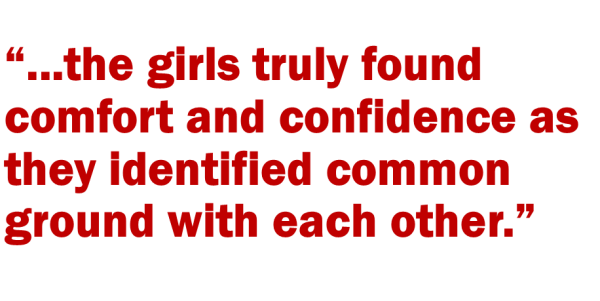 After a lot of hard work in recruitment and creating lesson plans, we had our first meeting in September of 2017. We were both excited and anxious that this day had finally arrived and that our hard work had paid off.
After a lot of hard work in recruitment and creating lesson plans, we had our first meeting in September of 2017. We were both excited and anxious that this day had finally arrived and that our hard work had paid off.
The excitement stemmed from our curiosity and hope that this one chapter could change our local community’s outlook. Our angst was in regards to the possibility that these fourteen high school girls - seven Jewish and seven Muslim - might not get along. To our pleasant surprise, the first meeting went exceptionally well and early friendships quickly began to form. Despite our previous concerns, the girls truly found comfort and confidence as they identified common ground with each other.
Since then, these friendships have taken flight and evolved through the process of giving back to our community. Our first charitable act was around the holiday season when we collected food cans, toiletries, and books for a local family shelter in Hartford. We unloaded and stocked hundreds of supplies that would be given to various families in need. This experience was a gateway to many more acts of service that brought us even closer as a sisterhood.
Soon after, we partnered with the Muslim Coalition of Connecticut to serve those in need of a healthy meal and a place to relax at Mercy Shelter in Hartford. Some of us were in charge of plating the food, while others waitressed. The facilitator for Mercy Shelter was so happy to have us all there and commented that we had the best teamwork he had ever seen. We look forward to going back this year and to gaining even more perspective.
The highlight of our year was teaching our own curriculum to 5th grade students at Beth El Hebrew School in West Hartford. For months our group spent time together creating an intricate lesson plan to teach these young students. The curriculum had a few different components, beginning with a Venn diagram activity that demonstrated the ways that Muslims and Jews are alike. The students soon caught on that every element was a part of both religions, falling into the center section of the diagram.
After many insightful discussions with the students, we then moved on to passing out a coloring page with the Jerusalem skyline on it. During that time, we played music in both Arabic and Hebrew. Lastly, we had each student write on a poster what they thought before versus what they know now, after the activity.
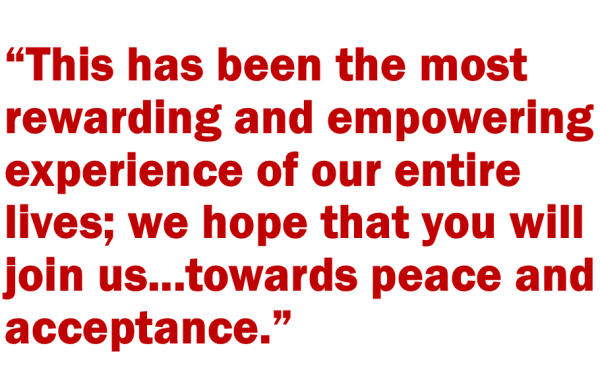 One student wrote on the before side of the poster that they feared “we might not be able to get along.” However, after our lesson they wrote on the after side of the poster that now they know “we are so similar and can be close friends.” It was truly inspiring to see how much new knowledge they acquired regarding the similarities between the two religions in just one short hour. The kids were so excited to learn this material and fascinated by the common ground.
One student wrote on the before side of the poster that they feared “we might not be able to get along.” However, after our lesson they wrote on the after side of the poster that now they know “we are so similar and can be close friends.” It was truly inspiring to see how much new knowledge they acquired regarding the similarities between the two religions in just one short hour. The kids were so excited to learn this material and fascinated by the common ground.
A few weeks ago we were contacted by the coordinator of the Hebrew school and asked to officially be a part of the curriculum for 5th grade students. We feel so fortunate that we will be able to make an even greater impact this year.
In just a few short weeks our chapter will reunite for the first meeting of this new school year! We look forward to another successful year full of friendship, knowledge, and service.
Next year, we are beginning another chapter in our lives as we head off to college. We both plan on bringing all we have learned to our universities, and hopefully starting the first Salaam Shalom college chapter! We urge you to begin making an impact by starting a new chapter of the sisterhood in your own community. For us, this has been the most rewarding and empowering experience of our entire lives; we hope that you will join us on our journey towards peace and acceptance!
_______________________________________
Olivia Rotter and Layan Alnajjar are seniors at William H. Hall High School in West Hartford; dedicated students and active leaders within their community. This year, they will continue helping to start new chapters across Northern America and will mentor future teen leaders, giving them advice and ideas for meetings. They will be honored for their hard work and devotion to the Sisterhood at the organization’s annual conference in November.
For more information about the sisterhood, visit https://sosspeace.org, follow the organization on facebook at the Sisterhood of Salaam Shalom, and follow their new teen-run instagram@sossteens.


 I sit before you now as someone past 70 wondering why you - strangers to me, members of this Public Health Committee as well as your colleagues in the CT General Assembly - get to decide what my end of life is going to be like. This is very real … and gets more real every day for me and thousands of other people in Connecticut.
I sit before you now as someone past 70 wondering why you - strangers to me, members of this Public Health Committee as well as your colleagues in the CT General Assembly - get to decide what my end of life is going to be like. This is very real … and gets more real every day for me and thousands of other people in Connecticut.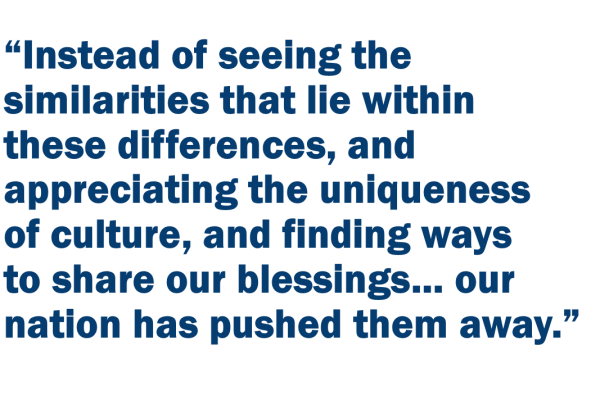 Instead of seeing the similarities that lie within these differences, and appreciating the uniqueness of culture, and finding ways to share our blessings… our nation has pushed them away. They have become a "them", divided from our population out of fear of these differences and blindness to the multitudes of commonalities. If you could talk to Reyna about her dream of being a doctor and how much she loves learning new words, if you could talk to Munir about his favorite songs and how he tells jokes to make friends… then you would see the similarities we share, and yet how many differences they face. However, do not be mistaken, this doesn't stop them.
Instead of seeing the similarities that lie within these differences, and appreciating the uniqueness of culture, and finding ways to share our blessings… our nation has pushed them away. They have become a "them", divided from our population out of fear of these differences and blindness to the multitudes of commonalities. If you could talk to Reyna about her dream of being a doctor and how much she loves learning new words, if you could talk to Munir about his favorite songs and how he tells jokes to make friends… then you would see the similarities we share, and yet how many differences they face. However, do not be mistaken, this doesn't stop them.
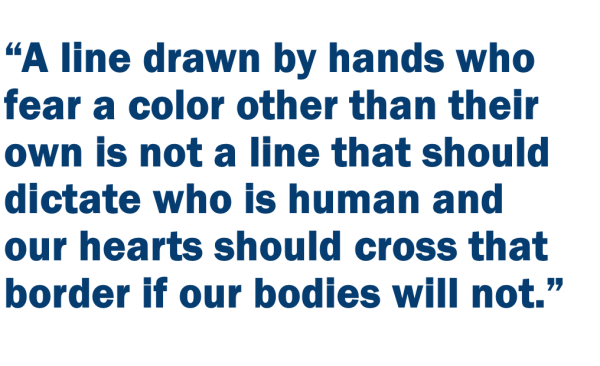 If you could see them the way I see them, as hard-working individuals that will do anything to provide for their family (like many of us would do), as welcoming neighbors who will open their doors to anyone...and as people. Not Mexicans, not drug-traffickers, not prostitutes, not foreigners, not aliens, not "them"...humans, people, children. These 11.6 million US citizens have names, stories, hopes, and families. The 303, 916 people who were apprehended at the Mexican border in 2017 have names, stories, hopes, and families. As do we.
If you could see them the way I see them, as hard-working individuals that will do anything to provide for their family (like many of us would do), as welcoming neighbors who will open their doors to anyone...and as people. Not Mexicans, not drug-traffickers, not prostitutes, not foreigners, not aliens, not "them"...humans, people, children. These 11.6 million US citizens have names, stories, hopes, and families. The 303, 916 people who were apprehended at the Mexican border in 2017 have names, stories, hopes, and families. As do we.
 In the Connecticut State Colleges and Universities (CSCU) system, unstable housing - or the lack of housing altogether – is a barrier to academic success and stability for many students. Faculty, counselors and deans report that students are living in cars and “couch surfing” at friends’ or relatives’ homes while, at the same time, they are trying to attend college because they know that education is their path to a better future. During Town Hall meetings across the state during the 2016-17 academic year, CSCU President Ojakian was approached by many students who said that they were homeless and needed additional support.
In the Connecticut State Colleges and Universities (CSCU) system, unstable housing - or the lack of housing altogether – is a barrier to academic success and stability for many students. Faculty, counselors and deans report that students are living in cars and “couch surfing” at friends’ or relatives’ homes while, at the same time, they are trying to attend college because they know that education is their path to a better future. During Town Hall meetings across the state during the 2016-17 academic year, CSCU President Ojakian was approached by many students who said that they were homeless and needed additional support.
 Of those schools reporting more than 30 individuals surveyed, the schools with the largest percentages of students experiencing a housing crisis are as follows: 38% at Gateway Community College with 42 students surveyed; 21% at Middlesex with 71 students surveyed; 26% at Eastern CT State University with 117 students surveyed; 19% at Housatonic with 320 students surveyed; 14% at Manchester Community College with 290 students surveyed; 13% at Three Rivers Community College with 164 surveys completed; 10% at Northwestern CCC with 88 completed surveys;11% at Asnuntuck with 81 surveys completed; 9% at Naugatuck Valley Community College with 243 completed surveys; 13% at Norwalk Community College with 72 surveys completed, and 38 surveys completed at Tunxis Community College with a 13% rate of housing instability and homelessness.
Of those schools reporting more than 30 individuals surveyed, the schools with the largest percentages of students experiencing a housing crisis are as follows: 38% at Gateway Community College with 42 students surveyed; 21% at Middlesex with 71 students surveyed; 26% at Eastern CT State University with 117 students surveyed; 19% at Housatonic with 320 students surveyed; 14% at Manchester Community College with 290 students surveyed; 13% at Three Rivers Community College with 164 surveys completed; 10% at Northwestern CCC with 88 completed surveys;11% at Asnuntuck with 81 surveys completed; 9% at Naugatuck Valley Community College with 243 completed surveys; 13% at Norwalk Community College with 72 surveys completed, and 38 surveys completed at Tunxis Community College with a 13% rate of housing instability and homelessness. ppression.
ppression. “These inventions of prudence cannot be less requisite in the distribution of the supreme powers of the State.”
“These inventions of prudence cannot be less requisite in the distribution of the supreme powers of the State.”
 In its 2018 Salary Guide for Accounting and Finance Professionals, Robert Half, a global staffing firm specializing in accounting and finance professionals, reports “There’s high demand for top talent in public accounting due to a severe shortage of skilled candidates…” Their “In-Demand Certifications” list puts “CPA” at the top.
In its 2018 Salary Guide for Accounting and Finance Professionals, Robert Half, a global staffing firm specializing in accounting and finance professionals, reports “There’s high demand for top talent in public accounting due to a severe shortage of skilled candidates…” Their “In-Demand Certifications” list puts “CPA” at the top.
 Why is this so important?
Why is this so important?
 If college students care more than ever about getting a job after graduation, then why are they struggling to find good jobs in a relatively strong economy? The disjunction here is apparent. Many potential factors can explain this disconnect, but one that I find prevalent on my campus is that all rising seniors seem to want to work in the same select few cities.
If college students care more than ever about getting a job after graduation, then why are they struggling to find good jobs in a relatively strong economy? The disjunction here is apparent. Many potential factors can explain this disconnect, but one that I find prevalent on my campus is that all rising seniors seem to want to work in the same select few cities.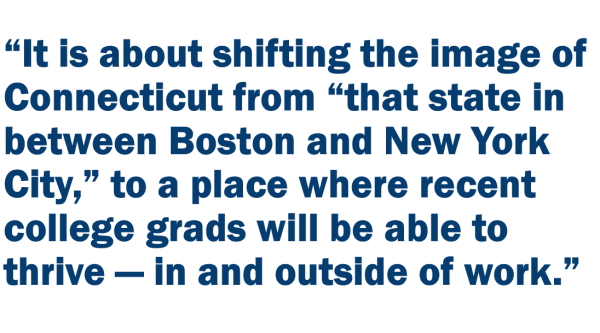
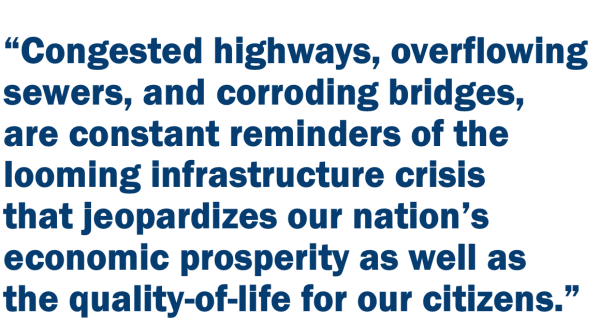 Congested highways, overflowing sewers, and corroding bridges, are constant reminders of the looming infrastructure crisis that jeopardizes our nation’s economic prosperity as well as the quality-of-life for our citizens. With new grades just published in 2017, the condition of our nation’s infrastructure has shown little to no improvement since receiving a collective grade of a C- in 1988 and with some areas even sliding toward failing grades.
Congested highways, overflowing sewers, and corroding bridges, are constant reminders of the looming infrastructure crisis that jeopardizes our nation’s economic prosperity as well as the quality-of-life for our citizens. With new grades just published in 2017, the condition of our nation’s infrastructure has shown little to no improvement since receiving a collective grade of a C- in 1988 and with some areas even sliding toward failing grades.



























